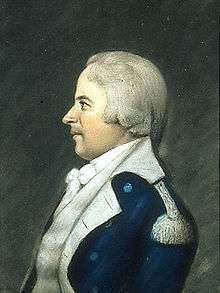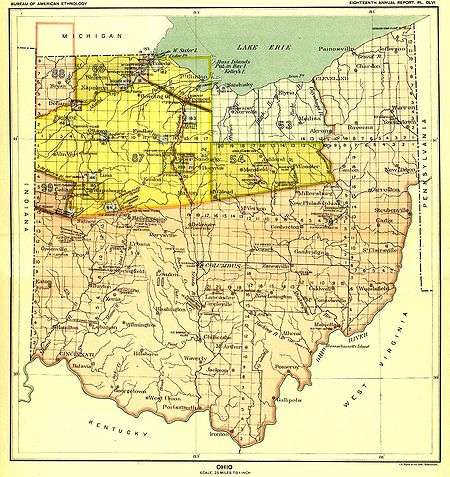Treaty of Brownstown


The Treaty of Brownstown was between the United States and the Council of Three Fires (Chippewa, Ottawa, Potawatomi), Wyandott, and Shawanoese Indian Nations. It was concluded November 25, 1808 at Brownstown in Michigan Territory, and provided cession of a strip of Indian land for a road to connect two disconnected areas of land previously ceded by Indians to the United States.
History
With the Treaty of Greenville in 1795 the Indian Nations ceded southern and eastern Ohio to white settlement.[1] The Treaty of Fort Industry in 1805 moved the boundary westward to a line 120 miles (190 km) west of Pennsylvania, which coincided with the western boundary of the Firelands of the Connecticut Western Reserve.[2] In 1807, the Treaty of Detroit called for the cession of lands northwest of the Maumee River, mostly in the Territory of Michigan.[3] The area between the Maumee River and the 1805 boundary remained Indian Lands, and thus, the United States could not legally build a road connecting settlements in Ohio and the Territory of Michigan. This area was also swampy, and would require much engineering effort and funds to cross with a road.
Treaty Provisions[4]
Article I
The parties agree a road would be beneficial to all parties, and to promote it, agree to the following articles.
Article II
The Indian Nations agree to “give, grant, and cede, unto the said United States, a tract of land for a road, of one hundred twenty feet in weadth, from the foot of the rapids of the river Miami of the Lake Erie, to the western line of the Connecticut reserve, and all the land within one mile of the said road, on each side thereof, for the purpose of establishing settlements along the same; also a tract of land, for a road only, of one hundred twenty feet in weadth, to run southwardly from what is called Lower Sandusky, to the boundary line established by the Treaty of Greenville, with the privilege of taking at all times, such timber and other materials, from the adjacent lands as may be necessary for making and keeping in repair the said road, with the bridges that may be required along the same.”
Note: Miami of the Lake Erie was the name of the Maumee river in that period. The foot of the rapids are at Perrysburg, Ohio. The western line of the Connecticut reserve is at Bellevue, Ohio along the line between Huron County, Ohio and Sandusky County, Ohio. Lower Sandusky was the name for Fremont, Ohio.
Article III
The lines mentioned in Article II will be run in directions thought most advisable by the President of the United States.
Article IV
The Indian nations retain the right to fish and hunt on the ceded lands, so long as the same shall remain property of the United States.
Note: The United States intended to sell land to private parties, so this was a temporary right.
Article V
The Indians nations acknowledge they are under the protection of the United States and no others.
Signatories
William Hull, Commissioner
Chippewas
- Ne-me-kas, or Little Thunder
- Puck-e-nese, or Spark of Fire
- Macquettequet, or Little Bear
- Shimnaquette
Ottawas
- Kewachewan
- Tondagane
Pottawatamies
- Mogau
- Wap-me-me, or White Pigeon
- Ma-che
Wyandotts
- Miere, or Walk in the Water
- I-yo-na-yo-ta-ha, or Joe
- Ska-ho, or Black Chief
- Adam Brown
Shawanoese
- Ma-ka-te-we-ka-sha, or Black Hoof
- Koi-ta-way-pie, or Col. Lewis
Consequences

In 1811,[5] Congress appropriated $6,000 to explore, survey and mark a road sixty feet wide. In 1815,[6] Congress made provisions to survey the lands one mile (1.6 km) either side of the road path and sell them at the Canton Land Office. No action was taken on either, so, in 1820, the Ohio legislature asked Congress to take action. In 1823, the land along route had already been ceded by the Indians and surveyed into townships and sections, and Congress authorized the state of Ohio to build the road, and granted land one mile (1.6 km) on each side of the road to the state, bounded by sectional lines.[7] This grant became known as the Maumee Road Lands. In 1825 Ohio appropriated moneys to build the road, and provided for sale of granted lands to pay for it. The section of road is about 46 miles (74 km) long, and the land granted to Ohio amounted to about 60,000 acres (240 km2).[8] United States Route 20 is situated along the Maumee road.
The road to run southwardly from Lower Sandusky mentioned in Article II was also not provided for by Congress. It became more desirable to run a road to Sandusky City on Lake Erie. In 1828,[9] Congress granted 49 sections of land along the path of the road, amounting to 31,596 acres (127.86 km2), to Ohio, in a grant known as the Turnpike Lands.[10] Ohio State Route 4 north of Bucyrus in Seneca and Crawford counties, and Ohio State Route 98 south of Bucyrus in Crawford and Marion counties are situated along the path of the Columbus and Sandusky Turnpike where the 1828 grant was made.
See also
Notes
- ↑ 7 Stat. 49 - Text of Treaty of Greenville Library of Congress
- ↑ 7 Stat. 87 - Text of Treaty of Fort Industry Library of Congress
- ↑ 7 Stat. 105 - Text of Treaty of Detroit Library of Congress
- ↑ 7 Stat. 112 - Text of Treaty of Brownstown Library of Congress
- ↑ 2 Stat. 668 - Text of Act of December 12, 1811 Library of Congress
- ↑ 3 Stat. 201 - Text of Act of February 4, 1815 Library of Congress
- ↑ 3 Stat. 727 - Text of Act of February 28, 1823 Library of Congress
- ↑ Peters 1918 : 319,320
- ↑ 4 Stat. 263 - Text of Act of April 17, 1828 Library of Congress
- ↑ Peters 1918 : 312–315
References
- Peters, William E (1918). Ohio Lands and Their Subdivision. W.E. Peters.